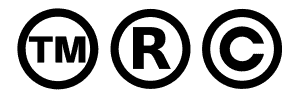Trademarks are words, phrases, symbols and/or designs that identify your business. Trademarks were established to distinguish the sources of goods from on to the other. Registering your trademark will allow you to strengthen and protect your rights. If you have started conducting business and are utilizing a logo, slogan and or design you may already have common law trademark rights in your geographic location even if you are not federally registered.
Let’s address two common trademark questions:
- What’s a Common Law Trademark?
- What’s the difference between a common law trademark and a federal trademark?
Common Law Trademark Rights
Common Law Trademark Rights provide some protection if you were the first to conduct business in your geographic area. The main two words to focus on are “first” and “geographic area”. Unclear lines come into play as businesses start to sell their goods across many cities and states. To ensure your business is protected nationwide, it is best to register your trademark federally through the United Stated Patent and Trademark Office, USPTO.
Let’s take a quick business example. Business A has a logo, is selling their goods in Woodbury, Minnesota and is not federally registered for their trademark. Business B comes along and starts selling their goods with a similar name and logo in Minnetonka, Minnesota. Although Business A started selling their goods first, they are only protected in their geographic location, Woodbury. This means Business B can conduct business as if trademark rights were theirs in that geographic location. This could prevent business A from expanding and conducting business in Minnetonka because Business B is already doing so under that name.
Although it’s a misconception that a U.S. trademark must be registered in order to be protected, common law trademark right protection isn’t as strong as one might believe. Take some time to review which path is best for your business.
Common Law Trademark vs. Federal Trademark Registration
The main difference between a common law trademark versus a registered trademark is the amount of protection one may receive and the location of the protection. Common law trademark protection is limited and when in court, it would be important to provide detailed proof with dates and location of sales.
Going back to our example above with Business A & B. If Business A federally registered their trademark and was approved, they would be able to conduct business in Woodbury and Minnetonka and would obtain the rights of the mark. Business B would not be able to utilize that mark and would have to conduct business under another name/mark. A registered trademark through the U.S. Patent and Trademark Office (USPTO Trademark) gives Business A the right to file a lawsuit to enforce their rights.
An unregistered trademark owner, also known as a common law trademark, can utilize the symbol “TM” which would notify the public that the owner is doing business with this mark. Whereas a registered trademark would be able to utilize the symbol “R” next to the trademark showing the public that the mark is federal protected. A unregistered trademark is prohibited from utilizing the “®” symbol. The “C” logo represents a copyright – which typically protects individual artistic works such as books and videos.
Unregistered Trademark Search & Trademark Protection
Prior to registering your trademark, it is important that you conduct a thorough search to avoid infringement. You can conduct an unregistered trademark search to verify your common law trademark protection on the internet and/or business directories in your geographic location. Companies such as NameCheck can perform a nationwide search that will analyze millions of existing trademarks, and review any threat in less than 15 seconds.
Once you receive feedback that your trademark protection is clear, you can use the USPTO Trademark application to begin the process of registering your trademark.
How long is a Trademark Protected?
A trademark will be protected for ten years if all statements, renewals and legal requirements are filed or paid timely. The first step is filing a statement of use with the application. In the fifth and sixth year the owner must file a “Declaration of Use” and an application for renewal between the night and tenth year after registration and every 10 years thereafter. If these documents are not filed timely, the registration will expire and will be canceled.
Although it is important to do your research and understand common law trademark or registered trademarks, it doesn’t mean you have to be the expert. With a growing business, you will have hundreds of to-do’s and hours of research and learning which can be quite daunting as a small business.


